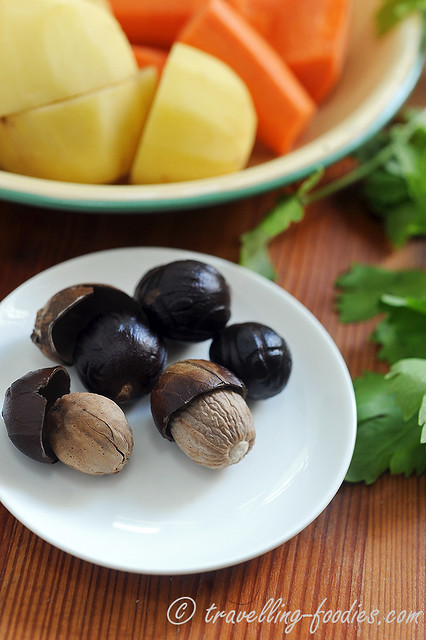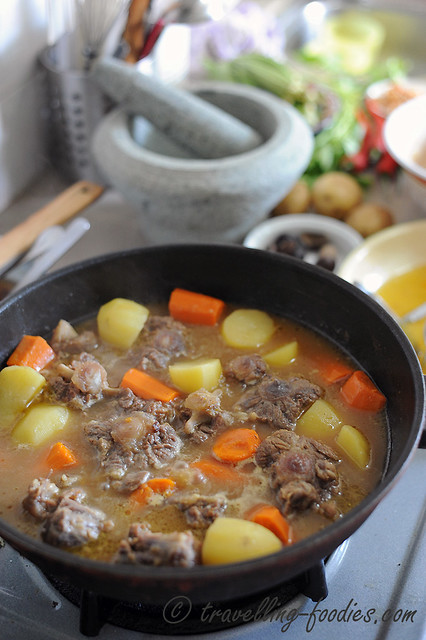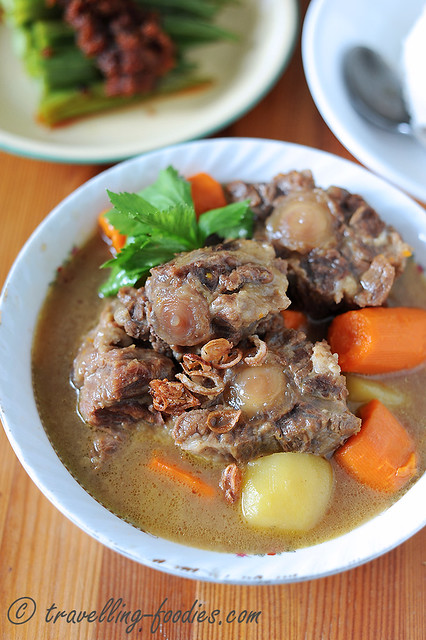Sup Buntut – Indonesian Oxtail Soup

I love oxtail for several reasons. The flavours from any meat off the bone is amazing, robust and rich. And what more with oxtail, it comes with lots of collagen! Oxtail is also a perfect cut for stewing, allowing the flavours to develop over prolonged periods of cooking, teasing out that essence of all the ingredients added. When I knew that there is an Indonesian oxtail soup called “Sup Buntut“, I knew I have to make it! And I’m glad I did… it was simply delish!

“Sup” as all of you would have figured, is literally homophonous to mean “soup” in Bahasa Indonesia. “Buntut” comes with a bit of a laugh. Bahasa Indonesia (BI) and Bahasa Melayu (BM) share may similar words within their lexicon. Afterall, one is evolved from the other. So speakers of BM would find BI strangely familiar but yet frustrating at the same time. Many “cuisine-related” words are common in both languages. For example, “bawang putih/puteh” is common to both languages to mean “garlic”. And the list extends endlessly, where speakers from both language would understand “daging” to mean “beef” while “ayam” is chicken. So definitely no problems with those. In some cases, the words take on a phonemic or morphological shift. Like “rojak” in BM takes on a vowel shift and becomes “rujak” in BI, while “satay” in BM and “sate” in BI may be spelt differently but essentially pronounced the same way and mean the same food! Now that’s still quite easy to understand yeah?
Now comes the “interesting” part… in some cases, the same word shared between BM and BI has different meanings! “Buntut” in BI actually means “tail” but in BM, they refer to a person’s buttocks! So you can imagine how hilarious it was when I first saw the name! It tickled me to no ends! On a slightly more serious note, it also reminds us to be mindful of any idiosyncratic differences in these two languages which are so similar yet different!

On the whole, the recipe is fairly straightforward with a few things to take note of. The chunks of oxtail have to be placed in boiling water for 5-10 mins or so. This is an important step! Any impurities and blood would ooze and coagulate as scum while some of the fats would dissolve into the water, rendering it oily. The boiling water is then discarded and replaced with a new pot. This process produces a soup which is lighter in taste, with greater clarity and most importantly, less oily which would have otherwise made drinking it very “jelak“. I love beef and mutton soups, be it the Indian Muslim “Sup Kambing” or the Chinese Hainanese style but one major deterrence which prevents me from enjoying them at the hawker centres and food courts is the thick layer of yellow oil which floats above the soup most of the time. So cooking it at home definitely gives us more control to make it tastier, if not healthier.
The minimum amount of oxtail one has to buy for this soup is one kilogram. Do not use anything less than that by halving the recipe as the finished product would not be as wholesome when not enough meat and bone is added. Conversely, I added more carrot than usual as it imparts a lovely natural sweetness from the vegetable. For the same reason, I added whole bulbs of garlic as well. Some recipes advocate the use of shallots, leeks or even spring onions of the same reason but I’d omitted them in this recipe. Feel free to add them, or even whole or halved yellow or red onions for the same purpose. But do note that these bulbs when cook thoroughly into the soup will become very mashy and invariably cause the soup to develop a final milky/cloudy appeal.

Another highlight of this soup is the use of nutmeg. Traditionally, whole nutmegs are used, crushed with a pestle before being sauteed slightly with ground pepper to accentuate the aroma and flavours. The result yields a soup which is perfumed beyond words!

Sup Buntut – Indonesian Oxtail Soup Recipe (serves 4)
Ingredients
1- 1.5 kg of oxtail, chopped into large chunks
300g potatoes, peeled and chopped into large chunks. Choose a “hard variety” like the Indonesian Brastagi Granola which can withstand long periods of cooking without disintegrating. Russets are a no no.
2-3 large carrots (appro. 250g), peeled and chopped into large chunks
3 bulbs of garlic
2 slices of ginger, julienned
1 whole nutmeg, bruised and crushed coarsely (can be replaced with 1 tsp of ground nutmeg)
2 tsp white peppercorns, toasted slightly and ground into powder
Garnishing – fried shallots, chopped chinese celery leaves
1 tsp of Indonesian sweet soy sauce (optional, for colouring)
1 tbsp cooking oil or butter
Salt to taste
water as required
Method
In a pot of boiling water, place ginger strips and oxtail chunks. Return to a boil and lower heat to medium-low. Allow to heat with lid on for 5 min.
Remove and drain oxtail chunks in a large bowl. Rinse slightly to remove and scum or impurities. Cut off any bits of remnant fat. Discard cooking water and ginger.
Add water to the pot and bring to a boil. Add oxtail chunks and cook for 1 hour or so until just tender. Skim the surface to remove any scum and oil periodically. DO NOT ADD ANY SEASONING AT THIS POINT! Half portion of the carrots and garlic are added at this point.
Meanwhile, saute crushed nutmeg and ground pepper with cooking oil or butter in a saucepan until aromatic. Add to the cooking oxtail.
After the oxtail is tender, add remaining carrots and potato. Season with salt as required. Soya sauce can also be added at this point for colour but that is entirely optional.
Allow to cook until vegetables are tender. The oxtail should be so soft and tender that the meat comes easily off the bone.
Ladle into a bowl, garnish with fried shallots and chopped chinese celery. Serve hot with rice and other dishes.
Slamat makan!

I am submitting this post to Asian Food Fest: Indonesia, hosted by Alice from I Love. I Cook. I Bake.

Leave a comment